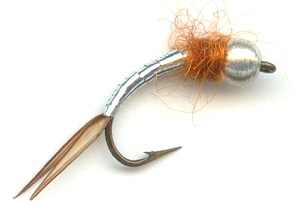Lightning Bug Beaded Nymph Fly
The Lightning Bug Beaded Nymph Fly was originally designed by J.Cliff Zug. It is thought to be a variation of a nymph called the kemp bug. It is one of those must have flies. It rates along with Pheasant Tail nymphs, With a silver bead head, silver body and forked tail this nymph could only be called one thing.

NYMPH FLY PATTERNS. Hook size 12 14 16 18 - $US each
The Lightning Bug nymph was developed in the early 1990's for the Yakima River in Washington. Since then it has become one of the more popular nymph patterns in Western America. From Washington state, the Lightning Bug quickly worked its way across the fly fishermen of Idaho, Wyoming and Montana. It crossed the U.S.- Canada border, and found its way into the fly boxes around the world. It's a deadly pattern to use on tailwaters but it will catch trout on all types of flowing waters. I like using it on a dropper. Last summer it out performed some of the more natural imitations I use. A good attractor nymph
TAILING TROUT
There is a trout feeding pattern that you should always be on the look out for. The tell tale sign is when you see a fish tail popping out of the water. The fish is head down in the weed, sometimes ripping out the weed with its mouth, trying to disturb all the shrimp, nymphs, pupa and scuds that have sort refuge in the weed. This is where they live and feed. This is the only way trout and grayling can get at weed imbedded insects and crustaceans. The fish dive aggressively head long into the weed mass with the object of panicking the residents to make a dash to an alternative place of safety. This is what the fish are after. They start to feed on all the fleeing food forms. Do not cast when you see tailing trout. Wait until the tails have disappeared and the fish are hunting. The harvesting of panicked insect phase is when the fly fisher can make the most impact. Place your fly in the feeding zone and let it let it drift at the mercy of the current and to tumble about just like the naturals. Give a short sharp strip to imitate them fleeing to escape.
CUSTOMER'S COMMENT
I caught five good sized trout on your lightning bug nymph on my last lake fishing trip. It was a hot day so I sought out the inlet stream. I concluded that it would be bringing in fresh insect food washed down from the hills. It would also providing a more comfortable hunting environment by introducing cooler more oxygen rich water. I was right. Fish tend to hold very close to where fresh water enters large still waters. I believe the sunlight reflecting of the silver body of the lightning bug helped them find it quickly. One tip though, you must always approach these areas carefully. The fish can see you if you get too close. Stand well back and keep low. Try to use natural cover like a big boulder or shrub. Where clothing that matches the colour of the sky or local landscape. - Craig Elison


Fly Fishing books

